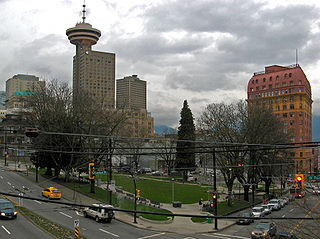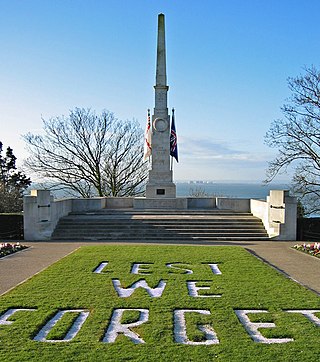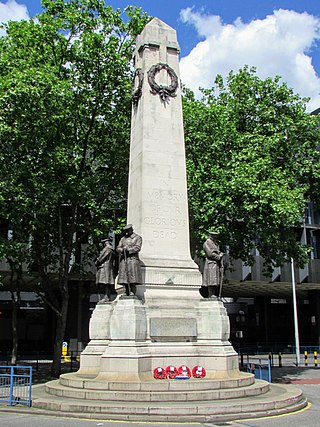Related Research Articles

The Tugu Negara is a national monument that commemorates those who died in Malaysia's struggle for freedom, principally against the Japanese occupation during World War II and the Malayan Emergency, which lasted from 1948 until 1960. It is located in the Federal capital, Kuala Lumpur. The Malaysian Houses of Parliament is situated near the monument.

Victory Square is a park in Vancouver, British Columbia, Canada. The square is bordered by West Hastings Street to the northeast, West Pender Street to the southwest, Cambie Street to the southeast, and Hamilton Street to the northwest. The term is also used to refer to the neighbourhood immediately surrounding the square.

The Monument of Remembrance, usually known by the nickname of the Gëlle Fra, is a war memorial in Luxembourg City. It is dedicated to the thousands of Luxembourgers who volunteered for service in the armed forces of the Allied Powers during both World Wars and the Korean War as well as the Luxembourgers who volunteered in the International Brigades during the Spanish Civil War.

Manchester Cenotaph is a war memorial in St Peter's Square, Manchester, England. Manchester was late in commissioning a First World War memorial compared with most British towns and cities; the city council did not convene a war memorial committee until 1922. The committee quickly achieved its target of raising £10,000 but finding a suitable location for the monument proved controversial. The preferred site in Albert Square would have required the removal and relocation of other statues and monuments, and was opposed by the city's artistic bodies. The next choice was Piccadilly Gardens, an area already identified for a possible art gallery and library; but in the interests of speedier delivery, the memorial committee settled on St Peter's Square. The area within the square had been had been purchased by the City Council in 1906, having been the site of the former St Peter's Church; whose sealed burial crypts remained with burials untouched and marked above ground by a memorial stone cross. Negotiations to remove these stalled so the construction of the cenotaph proceeded with the cross and burials in situ.

The Old Steine Gardens in Brighton, Brighton and Hove, East Sussex, England, adjacent to the Old Steine thoroughfare, are the site of several monuments of national historic significance.

Redheugh Gardens War Memorial or Hartlepool War Memorial is a World War I and World War II memorial located in the Headlands of Hartlepool, County Durham, England. It commemorates Hartlepool military servicemen and civilians who lost their lives in both wars – with specific mention of the first British soldiers to have died on British soil during 16 December 1914 Raid on Scarborough, Hartlepool and Whitby of World War I. In 2001 a plaque was unveiled to memorialise 240 men and women who succumbed from 1919 to 1967 during war and conflict.
The Hartlepool War Memorial may refer to the World War I and II war memorials in Hartlepool, County Durham, England:

The Statue of Queen Victoria stands on the western side of Victoria Square, St Helens, Merseyside, England. It was created after the death of Queen Victoria and given to the town by Colonel William Windle Pilkington, mayor of St Helens in 1902, and a member of the Pilkington glass manufacturers in the town. Pilkington commissioned George Frampton to design it. Frampton used the same model for the figure of the queen for two other statues, but placed it on thrones and pedestals of different designs. The St Helens statue was unveiled by the Earl of Derby in 1905. Originally placed in the centre of Victoria Square, it was moved to a position on the west side of the square in 2000. The statue is recorded in the National Heritage List for England as a designated Grade II* listed building.

Southport War Memorial is in London Square, Lord Street, Southport, Merseyside, England. It consists of an obelisk flanked by two colonnades in the form of Greek temples. Outside the colonnades are memorial gardens, each containing a Pool of Remembrance and fountains. The memorial was designed by the local architects Grayson and Barnish, and the carving was executed by Herbert Tyson Smith. It was unveiled in 1923 by the Earl of Derby. Following the Second World War and subsequent conflicts further inscriptions and names have been added. The memorial is recorded in the National Heritage List for England as a designated Grade II* listed building.

The North Borneo War Monument is a monument that was erected on 8 May 1923 by the North Borneo Chartered Company in Bond Street, Jesselton, British North Borneo. Originally, it was a memorial for the fallen British soldiers in World War I but later extended to include the Australian soldiers in World War II. The monument stands today in the city park of Kota Kinabalu, the capital of the Malaysian state of Sabah.

Gair Park is a heritage-listed park and memorial at 181 Annerley Road, Dutton Park, City of Brisbane, Queensland, Australia. It was built from 1936 onwards. It was added to the Queensland Heritage Register on 5 April 2004.

Southend-on-Sea War Memorial, or Southend War Memorial, is a First World War memorial in Southend-on-Sea, Essex, in south-eastern England. It was designed by Sir Edwin Lutyens and unveiled in 1921. Southend-on-Sea is a seaside resort famous for its pleasure pier, which was used by the military during the First World War. The town was a stopping point for soldiers en route to the front and, as the war drew on, it also became an important disembarkation point for the evacuation of injured troops. This saw the conversion of several buildings in Southend into hospitals.

The Cenotaph is a war memorial in George Town within the Malaysian state of Penang. Constructed in 1929, the memorial commemorates Allied servicemen who lost their lives during World War I. Located at the city's Esplanade, it serves as a venue for Remembrance Day ceremonies.

The Lancashire Fusiliers War Memorial is a First World War memorial dedicated to members of the Lancashire Fusiliers killed in that conflict. Outside the Fusilier Museum in Bury, Greater Manchester, England, it was unveiled in 1922—on the seventh anniversary of the landing at Cape Helles, part of the Gallipoli Campaign in which the regiment suffered particularly heavy casualties. The memorial was designed by Sir Edwin Lutyens. He was commissioned in light of a family connection—his father and great uncle were officers in the Lancashire Fusiliers, a fact noted on a plaque nearby. He designed a tall, slender obelisk in Portland stone. The regiment's cap badge is carved near the top on the front and rear, surrounded by a laurel wreath. Further down are inscriptions containing the regiment's motto and a dedication. Two painted stone flags hang from the sides.

The London and North Western Railway War Memorial is a First World War memorial located outside Euston station in London, England. The memorial was designed by Reginald Wynn Owen, architect to the London and North Western Railway (LNWR), and commemorates employees of the LNWR who were killed in the First World War. Some 37,000 LNWR employees left to fight in the war—around a third of the company's workforce—of whom over 3,000 were killed. As well as personnel, much of the company's infrastructure was turned over to the war effort. Of the £12,500 cost of the memorial, £4,000 was contributed by the employees and the company paid the remainder.

Coventry War Memorial stands at the centre of War Memorial Park, to the south of the city of Coventry in England. The memorial is a tapering tower 87 feet (27 m) high, completed in 1927. It was restored in 2011, and designated as a Grade II* listed building in January 2013. At the same time, the park was itself listed at Grade II, and the gates and gate posts at the park's main entrance were separately Grade II listed.

The Barnet Boys School Boer War Memorial is located opposite Christ Church on the St Albans Road in Chipping Barnet, London. It marks the deaths of the eight former pupils of Barnet Boys School who died in the Second Boer War of 1899 to 1902 and was unveiled by Field Marshal Lord Grenfell in July 1903. It has been grade II listed on the National Heritage List for England since June 2017. The heritage listing describes the monument as "simple yet dignified".

Pialba Memorial Cenotaph is a heritage-listed memorial at Freedom Park, Main Street, Pialba, Fraser Coast Region, Queensland, Australia. It was designed by Philip Oliver Ellard Hawkes and built from 1918 to 1921 by Frederick William Webb. It was added to the Queensland Heritage Register on 6 May 2016. It is also known as the Pialba War Memorial and the Hervey Bay War Memorial.

Leeds War Memorial stands on Victoria Square on the Headrow, to the east of Town Hall and to the south of Leeds City Art Gallery in Leeds, England. It was erected as a memorial to those who had fallen in the First World War. The memorial was designed by Henry Charles Fehr (1867–1940) and unveiled on 14 October 1922 by Viscount Lascelles.

Harrogate War Memorial, also known colloquially as Harrogate Cenotaph, in Harrogate, North Yorkshire, England, was designed by Ernest Prestwich and unveiled by Henry Lascelles, 5th Earl of Harewood in 1923, in the presence of 10,000 people. It was said to be one of the last of England's outdoor war memorials to be unveiled, following the First World War.
References
- 1 2 West Hartlepool War Memorial 1914 – 1919: Unveiling & Dedication. Hartlepool Central Library: 22 page digital copy (pdf) of the West Hartlepool War Memorial 1914 – 1919: Invitation to the unveiling of the War Memorial in 1923, Order of Service, and Unveiling & Dedication, shelved at Reference 940.465. 1923. Bib Id 300313.
- 1 2 Central Neighbourhood Consultative Forum Agenda – 4 December 2008. Hartlepool Borough Council. Retrieved 9 September 2012.
- 1 2 3 Central Neighbourhood Consultative Forum Agenda – 16 February 2006. Hartlepool Borough Council. Retrieved 9 September 2012.
- 1 2 3 War Memorial in Victory Square, Hartlepool. British Listed Buildings. Retrieved 4 September 2012.
- 1 2 3 4 5 6 7 8 West Hartlepool War Memorial. North East War Memorials Project. Retrieved 4 September 2012.
- 1 2 West Hartlepool History. This is Hartlepool. Retrieved 7 September 2012.
- ↑ Obelisk 1914–18 Victory Square. North East War Memorials Project. Retrieved 4 September 2012.
- ↑ Shipbuilding and shipping record, Volume 18. 1921. p. 285.
- ↑ . News in Brief. The Times. No. 42801. London. 17 August 1921. p. 5.
{{cite news}}: Missing or empty|title=(help) - ↑ Edwards, Martin (6 December 2005). Hartlepool (West) War Memorial. Roll of Honour. Retrieved 4 September 2012.
- 1 2 3 4 5 Men and Women of Hartlepool. United Kingdom National Inventory of War Memorials (UKNIWM). Retrieved 4 September 2012.
- 1 2 "West Hartlepool War Memorial". News in Brief. The Times. No. 43470. London. 12 October 1923. p. 15.
- ↑ D. G. Somerville and Company. Grace's Guides: British Industrial History. Retrieved 11 September 2012.
- ↑ Youth Column 1914 Redheugh Gardens. North East War Memorials Project. Retrieved 10 September 2012.
- ↑ Pillars 1939 & later Victory Square. North East War Memorials Project. Retrieved 7 September 2012.